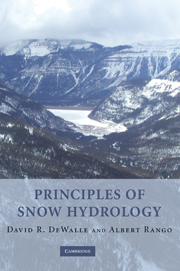Book contents
- Frontmatter
- Contents
- Preface
- 1 Introduction
- 2 Snow climatology and snow distribution
- 3 Snowpack condition
- 4 Ground-based snowfall and snowpack measurements
- 5 Remote sensing of the snowpack
- 6 Snowpack energy exchange: basic theory
- 7 Snowpack energy exchange: topographic and forest effects
- 8 Snowfall, snowpack, and meltwater chemistry
- 9 Snowmelt-runoff processes
- 10 Modelling snowmelt runoff
- 11 Snowmelt-Runoff Model (SRM)
- 12 Snowpack management and modifications
- Appendix A Physical constants
- Appendix B Potential solar irradiation theory
- Index
- Plate Section
- References
3 - Snowpack condition
Published online by Cambridge University Press: 18 August 2009
- Frontmatter
- Contents
- Preface
- 1 Introduction
- 2 Snow climatology and snow distribution
- 3 Snowpack condition
- 4 Ground-based snowfall and snowpack measurements
- 5 Remote sensing of the snowpack
- 6 Snowpack energy exchange: basic theory
- 7 Snowpack energy exchange: topographic and forest effects
- 8 Snowfall, snowpack, and meltwater chemistry
- 9 Snowmelt-runoff processes
- 10 Modelling snowmelt runoff
- 11 Snowmelt-Runoff Model (SRM)
- 12 Snowpack management and modifications
- Appendix A Physical constants
- Appendix B Potential solar irradiation theory
- Index
- Plate Section
- References
Summary
Once snow has accumulated on the landscape, the individual ice grains can be rapidly transformed or metamorphosed into a structured snowpack. Metamorphism ultimately influences the thermal conductivity and liquid permeability of the snowpack that in turn influence the snowpack temperature regime and storage and release of liquid water. Snowpacks vary seasonally from low density, subfreezing snowpacks capable of refreezing any liquid-water inputs to isothermal, dense snowpacks that rapidly transmit liquid water to the ground below. In this chapter, important processes controlling snowpack metamorphism and the conduction of heat and liquid water in snow are described along with some methods hydrologists use to describe snowpack condition.
Snowpack metamorphism
Snow crystals that fall from the atmosphere undergo changes in size and shape over time as they become part of the snowpack. Owing to their large surface area to volume ratio, crystals are quite unstable in the snowpack and can transform to rounded or faceted ice grains. Processes causing metamorphism of ice grains and snowpacks vary between dry snow and wet snow. Metamorphism within the snowpack is important to hydrologists because it can ultimately lead to changes in thermal conductivity and liquid permeability that influences the snowpack energy budget and release of meltwater. The following discussion of snowpack metamorphism is largely based upon writings by Perla and Martinelli (1978) and McClung and Schaerer (1993). Major snowpack processes for snowpack metamorphism are summarized in Table 3.1.
- Type
- Chapter
- Information
- Principles of Snow Hydrology , pp. 48 - 75Publisher: Cambridge University PressPrint publication year: 2008
References
- 2
- Cited by



